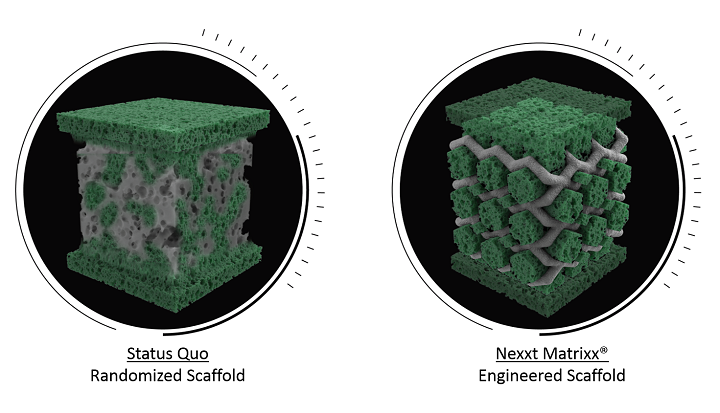Founded in 2009, Indiana-based medical device company Nexxt Spine first invested in metal 3D printing two years ago, with the purchase of its first Concept Laser Mlab 100R system. The company works in the expanding spinal cage sector and is working to increase procedural efficiency and patient outcomes for those suffering from debilitating spinal conditions. While Nexxt Spine originally used more traditional manufacturing methods to fabricate specialty spinal plates, rods, and screws, the business is scaling rapidly and increasing its metal additive investment with the installation of its fourth and fifth Mlab 100R systems from GE Additive this month.
Alaedeen Abu-Mulaweh, the director of engineering at Nexxt Spine, stated, “Additive is booming.”
 Nexxt Spine aims to drive medical device innovation, and designs, manufactures, and distributes all of its spinal implants from its Noblesville facility. With its latest 3D printer purchase, the company is looking to, as GE Additive put it, “tap further into the growing global spinal implant market.”
Nexxt Spine aims to drive medical device innovation, and designs, manufactures, and distributes all of its spinal implants from its Noblesville facility. With its latest 3D printer purchase, the company is looking to, as GE Additive put it, “tap further into the growing global spinal implant market.”
“We are seeing ongoing adoption of additive manufacturing in the orthopaedic industry and an exciting shift from research and development to serial production,” said Stephan Zeidler, senior global and key accounts director for the medical sector at GE Additive. “Early innovators like Nexxt Spine are scaling up and there is a significant increase in production volumes.”
By continuing to invest in Concept Laser’s LaserCUSING metal 3D printing technology, which has been used in medical and military applications, to name just a few, Nexxt Spine is able to eliminate the need for contract manufacturers. Because it now owns the whole design, production and distribution process on-site, the company can increase how quickly it develops and commercializes its spinal implants.
“We used the first Mlab primarily for R&D purposes, but we soon realised that further investment in additive technology could add value not only to our overall growth strategy, but also at a clinical application level with the ability to develop implants with very intricate micro-geometries that could maximise healing,” Alaedeen explained. “Over the past two years, we have made a seamless jump from R&D to serial production and in doing so have significantly accelerated the time from concept to commercialization.
“Like I said, additive is absolutely booming. It is driving our business and innovation strategy forward and our design team is actively developing and testing new applications, parameters and surgical devices to target new markets. We are excited for what the future holds for us.”
Nexxt Spine knows what it’s talking about when it comes to designing, developing, and fabricating spinal fusion implants – its products use interconnected micro-lattice architectures to promote osteoconduction, osteointegration, and boney fusion. A flagship product introduced in 2017 is the company’s Nexxt Matrixx System, which includes multiple porous titanium spinal fusion implants that combine novel 3D printed cellular scaffolding with highly differentiated surface texturing technology.
The company blends cellular porosity that’s inspired by the natural biology of bones with the underlying fundamentals of engineering in order to create fusion-optimized, structurally sound medical devices. This is a big difference from other medical manufacturers that use 3D printing to create devices which merely mimic the trabecular geometry of bone.
“Titanium – porous or otherwise – is physically incapable of biological remodeling, so using additive to directly mimic the structural randomness of bone doesn’t make a whole lot of sense,” Alaedeen explained. “Rather than simply looking like bone, Nexxt Matrixx® was designed with functionality in mind to fulfil our vision of actively facilitating the body’s natural power of cellular healing.”
Now that Nexxt Spine has shifted to serial additive manufacturing production and moved all of its design, manufacturing and distribution functions on-site in Indiana, it will be able to service customers and scale up as much as it needs to continue meeting the increased demand for better spinal fusion implants.
Zeidler concluded, “Nexxt Spine is another great example that shows the power of our Mlab machine, which is proven to be an easily accessible machine for research & development, with the capability to be a reliable, scalable and modular production machine at the same time.”
Discuss this story and other 3D printing topics at 3DPrintBoard.com or share your thoughts in the comments below.
[Images provided by GE Additive]Subscribe to Our Email Newsletter
Stay up-to-date on all the latest news from the 3D printing industry and receive information and offers from third party vendors.
You May Also Like
Profiling a Construction 3D Printing Pioneer: US Army Corps of Engineers’ Megan Kreiger
The world of construction 3D printing is still so new that the true experts can probably be counted on two hands. Among them is Megan Kreiger, Portfolio Manager of Additive...
US Army Corps of Engineers Taps Lincoln Electric & Eaton for Largest 3D Printed US Civil Works Part
The Soo Locks sit on the US-Canadian border, enabling maritime travel between Lake Superior and Lake Huron, from which ships can reach the rest of the Great Lakes. Crafts carrying...
Construction 3D Printing CEO Reflects on Being Female in Construction
Natalie Wadley, CEO of ChangeMaker3D, could hear the words of her daughter sitting next to her resounding in her head. “Mum, MUM, you’ve won!” Wadley had just won the prestigious...
1Print to Commercialize 3D Printed Coastal Resilience Solutions
1Print, a company that specializes in deploying additive construction (AC) for infrastructure projects, has entered an agreement with the University of Miami (UM) to accelerate commercialization of the SEAHIVE shoreline...

































